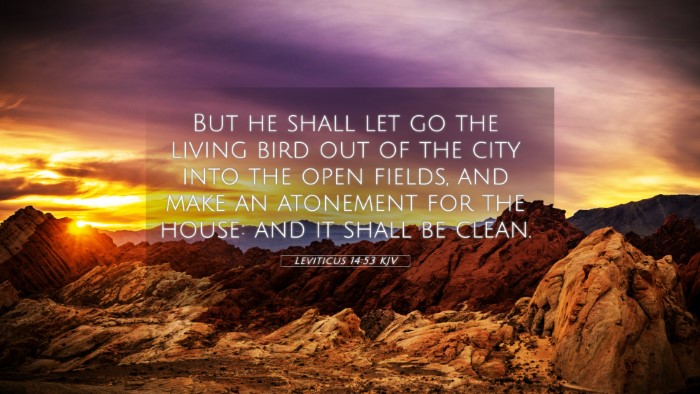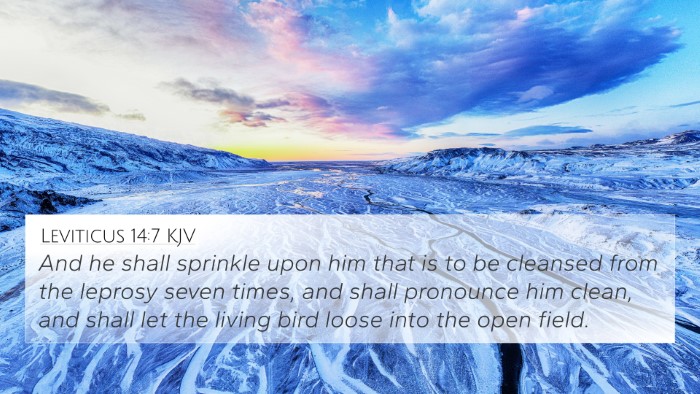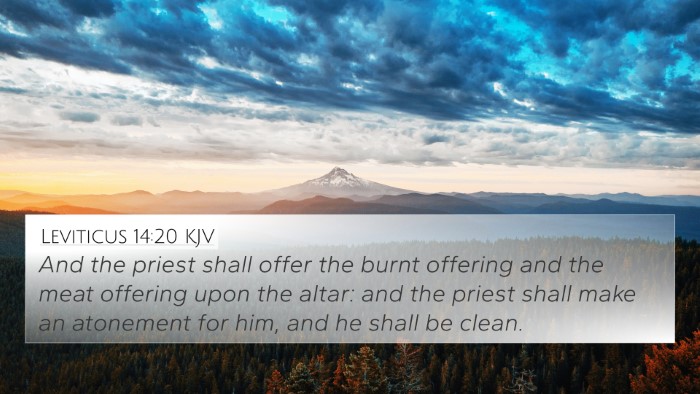Exploration of Leviticus 14:53
Leviticus 14:53 states:
“But he shall let go the live bird out of the city into the open fields, and make an atonement for the house: and it shall be clean.”
Meaning and Interpretation
The verse serves as a conclusion to the ritual regarding the purification of a house affected by leprosy. In this passage, God outlines the final steps for making an atonement for the house, emphasizing the importance of purification and restoration in the community of faith.
Insights from Public Domain Commentaries
Matthew Henry's Commentary
Matthew Henry highlights that the ritual not only serves a physical purpose but also a spiritual one, reflecting God's concern for holiness both in individual lives and the community of His people. The live bird released into the open fields symbolizes the removal of sin and impurity, much like the scapegoat ritual established in Leviticus 16.
Albert Barnes' Notes
Albert Barnes emphasizes the significance of the live bird, which is let go to signify the complete cleansing and dedication of the space back to God. He notes that this act of letting go into the fields served as a visual metaphor for the release of atonement, pointing to the greater sacrifice and atonement achieved through Christ.
Adam Clarke's Commentary
Adam Clarke provides a historical perspective regarding the cultural implications of such a ritual. He explains that these purification laws were critical to maintain the health and spiritual integrity of the Israelite community. Clarke also draws connections between these ancient practices and New Testament teachings about spiritual cleansing and the role of Christ as the ultimate atonement.
Related Cross References
- Leviticus 16:10 - Discusses the scapegoat and its significance in atonement.
- Hebrews 9:7 - Relates to the blood rituals and purification laws of the Old Testament.
- Matthew 8:3 - Jesus cleanses a leper, demonstrating His authority and the fulfillment of these rituals.
- 1 John 1:7 - Speaks to the cleansing power of Christ’s blood.
- Numbers 19:11-12 - Discusses the need for purification after contact with the dead, linking to the theme of cleanliness.
- John 1:29 - John the Baptist declares Jesus as the Lamb of God who takes away the sin of the world, paralleling Old Testament sacrificial themes.
- Isaiah 1:18 - God’s call for Israel to be made clean and the offer of forgiveness.
Thematic Connections
This verse showcases several thematic connections between various Biblical texts. It highlights:
- The necessity of atonement in both the Old and New Testaments.
- The symbolism of birds in Biblical practices, indicative of deliverance and peace.
- The importance of physical and spiritual cleanliness in God’s covenant community.
- The concept of God’s mercy manifesting through rituals aimed at restoration.
Conclusion
The significance of Leviticus 14:53 extends beyond its immediate context, offering deep insights into the nature of God’s holiness, the necessity of atonement, and the foreshadowing of Christ’s redemptive work. By understanding this verse through a cross-referential lens, one can see a richer tapestry of scripture that emphasizes God’s unwavering commitment to purify and reconcile His people.
Search Intent and Keywords
This exploration is aimed at providing readers with a deeper understanding of Biblical scripture, particularly through the lens of cross-referencing. For those looking to discover:
- What verses are related to Leviticus 14:53.
- Identifying connections between Old and New Testament themes.
- Bible verses that support and illustrate the core message of this verse.




